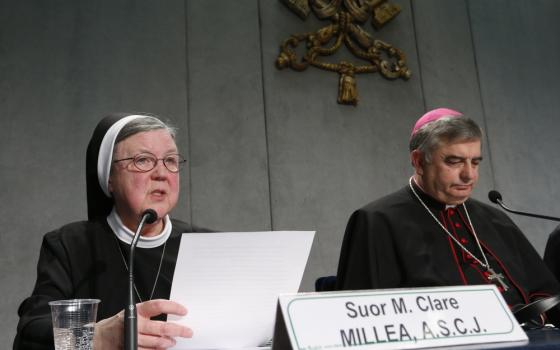When Mother Mary Clare Millea, the apostolic visitator to U.S. women religious, took the microphone at the press conference presenting the visitation’s final report, her address proved just how emotional the three-year visitation process had been.
Holding back tears, she thanked the report’s authors – Cardinal João Bráz de Aviz and Archbishop José Rodríguez Carballo – for hearing sisters’ voices and concerns.
“Your message to us today shows that you do understand our ongoing struggle to faithfully serve the church in challenging times, despite our shortcomings and limitations,” she continued, as the conference’s moderator placed a hand on her arm.
Her tears – for many sisters – made sense, given what they viewed as the arduous nature of the task Millea, superior general of the Apostles of the Sacred Heart of Jesus, had undertaken when she agreed to head the apostolic visitation.
“I think that poor woman was put in a very awkward position,” said Sr. Catherine Walsh, a member of the general council of the Dominican Sisters of Hope. “Representing the Vatican as an investigator, in a sense, against her fellow sisters in the country – that’s tough.”
Yet both Millea as a visitator and the final report based on her findings have largely been hailed as positive. As she visited various congregations across the country, sisters say she was respectful and sensitive. The final report, which many view as an olive branch from the Vatican, is peppered with invitations for dialogue, not to mention many thanks for the work women religious have done in the U.S.
The visitation’s final report demonstrates a marked change in tone from the language used to announce it: Gone are the insinuations that women religious in the U.S. have been unfaithful to church teachings. Gone, too, are the hints that by their supposed infidelity, sisters have caused their own numbers to drop.
However, encouraging as the final report may be, it marks the end of an event that was anything but positive for many sisters. When the visitation was announced in 2009, many women religious felt hurt and betrayed by the church to which they had given their entire lives.
Speaking at an event in Chicago last month, Sr. Mary Ann Zollmann, co-editor of the book The Power of Sisterhood: Women Religious Tell the Story of the Apostolic Visitation, shared a haunting experience that took place in the aftermath of the Vatican decision.
“I’ll never forget gripping the hand of a dying sister who wondered if we had been faithful,” said Zollmann, a Sister of Charity of the Blessed Virgin Mary. “‘We have done the right thing, haven’t we?’ she asked.”
The visitation also initially brought up old tensions between congregations affiliated with the more progressive Leadership Conference of Women Religious and the more traditional Council of Major Superiors of Women Religious, which officially split from LCWR in 1992.
Though communities from both leadership councils were visited, most of Millea’s teams of visitators were made up of sisters from CMSWR-affiliated congregations – at least in part because some LCWR members didn’t want to join the teams. Furthermore, shortly after the Vatican announced the apostolic visitation, it also launched a parallel doctrinal investigation of LCWR, but not CMSWR.
According to many sisters, those tensions were mitigated by the sensitive way in which the on-site audits were conducted.
Sr. Vincent Marie Finnegan, a Carmelite Sister of the Most Sacred Heart and a CMSWR founding board member, says the audits actually helped to facilitate healing, at least where the two leadership conferences were concerned.
“My experience in listening to the sisters involved is that it was a positive, grace-filled time which gave both groups an opportunity to share on one-to-one basis some of the joys, sorrows, concerns of both groups,” she wrote in an email to Global Sisters Report. “This in itself is healing, especially for those who have felt misunderstood and ‘not heard’ over the years.”
In that same vein, Sr. Pat McDermott, president of the Institute of the Sisters of Mercy, said that if the final report’s new tone doesn’t exactly erase the pain of the past, it at least provides a pathway to healing.
“The report is a significant moment in the healing process,” she said. “Healing is always a process; it’s not a moment. The invitation to dialogue – the invitation into deeper communion, the invitation into mutuality – is very genuine, and I think women religious will respond positively to that.”
By and large, that has been the case, though a number of sisters maintain that the reconciliation language found in the report does not go far enough. They would like an apology, though they are unlikely to get one, said Sacred Heart Sr. Jean Bartunek, a Boston College organizational theory professor who studied the visitation in 2011.
“The Vatican doesn’t do apologies,” she said. “By not talking about being obedient to the church, this report is as close as it’s likely to come to an apology.”
Walsh agrees, and like Bartunek, Finnegan and McDermott, she thinks sisters should embrace the opportunity to move forward, if they haven’t already.
“It’s not worth the energy,” she said. “Our task is to go forward with our service. We felt we’ve been faithful to the church all along and so we just continue to be faithful.”
[Dawn Cherie Araujo is staff reporter for Global Sisters Report, based in Kansas City, Mo. Follow her on Twitter @ Dawn_Cherie.]

